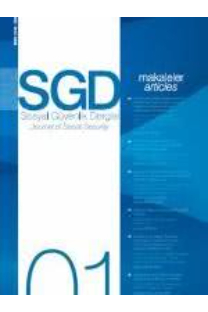Türkiye'de Engelli İstihdamının Çok Kriterli Karar Verme Yöntemleri ile Değerlendirilmesi
Evaluation of Disability Employment with Multi-Criteria Decision Making Methods in Turkey
___
- Alp, İ., Öztel, A. ve Köse, M. S. (2015). Entropi tabanlı MAUT Yöntemi ile Kurumsal Sürdürülebilirlik Performansı Ölçümü: Bir Vaka Çalışması. Ekonomik ve Sosyal Araştırmalar Dergisi. 11(2). 65-81.
- Altın, F. G., Karaatlı, M. ve Budak, İ. (2017). Avrupa’nın En Büyük 20 Havalimanının Çok Kriterli Karar Verme Yöntemleri ve Veri Zarflama Analizi ile Değerlendirilmesi. Suleyman Demirel University Journal of Faculty of Economics & Administrative Sciences. 22(4).
- Bennett, C. A. ve Lumsdaine, A. A., (1975). Evaluation and Experiment. Some Critical Issues in Assessing Social Programs. Academic Press, Inc. New York, San Francisco. London.
- Canbolat, Y. B., Chelst, K. ve Garg, N. (2007). Combining Decision Tree and MAUT for Selecting a Country for a Global Manufacturing Facility. Omega. 35(3). 312-325. doi: 10.1016/j.omega.2005.07.002
- Chan, E. H., Suen, H. C. ve Chan, C. K. (2006). MAUT-based Dispute Resolution Selection Model Prototype for International Construction Projects. Journal of Construction Engineering and Management. 132(5). 444-451. doi: 10.1061/(asce)0733-9364(2006)132:5(444)
- Chan, J. W. ve Tong, T. K. (2007). Multi-Criteria Material Selections and End-Of-Life Product Strategy: Grey Relational Analysis Approach. Materials & Design. 28(5). 1539-1546. doi: 10.1016/j.matdes.2006.02.016
- Collins, T. R., Rossetti, M. D., Nachtmann, H. L. ve Oldham, J. R. (2006). The Use of Multi-Attribute Utility Theory to Determine The Overall Best-in-Class Performer in a Benchmarking Study. Benchmarking: An International Journal. 13(4). 431-446. doi: 10.1108/14635770610676281
- Çakır, S. ve Perçin, S. (2013). AB Ülkelerinde Bütünleşik Entropi Ağırlık- TOPSİS Yöntemiyle Ar-Ge Performansının Ölçülmesi. Uludağ Üniversitesi İktisadi ve İdari Bilimler Fakültesi Dergisi. 32(1). 77-95.
- Dean Ting, P. K., Zhang, C., Wang, B., Deshmukh, A. ve Dubrosky, B. (1999). Product and Process Cost Estimation with Fuzzy Multi-Attribute Utility Theory. The Engineering Economist. 44(4). 303-331. doi: 10.1080/00137919908967526.
- Deng, J., (1989). Introduction to Grey System Theory. The Journal of Grey System. 1(1). 1-24.
- Doyle, B. (1987). 3. Disabled Workers, Employment Vulnerability and Labour Law. Employee Relations. 9(5), 20-29. doi: 10.1108/eb055105.
- Elitaş, C., Eleren, A., Yıldız, F. ve Doğan, M. (2012). Gri İlişkisel Analiz ile Sigorta Şirketlerinin Performanslarının Belirlenmesi, 16.Finans Sempozyumu. 521-530.
- Hartati, S., Wardoyo, R. ve Harjoko, A. (2012). ELECTRE-Entropy Method in Group Decision Support System Modelto Gene Mutation Detection. International Journal of Advanced Research in Artificial Intelligence. 1(1). 58-63.
- Ji, Y., Huang, G. H. ve Sun, W. (2015). Risk Assessment of Hydropower Stations through an Integrated Fuzzy Entropy-Weight Multiple Criteria Decision Making Method: A Case Study of The Xiangxi River. Expert Systems with Applications. 42(12). 5380-5389. doi: 10.1016/j.eswa.2014.12.026.
- Kailiponi, P. (2010). Analyzing Evacuation Decisions Using Multi-Attribute Utility Theory (MAUT). Procedia Engineering. 3. 163-174. doi: 10.1016/j.proeng.2010.07.016.
- Karaatlı, M., Ömürbek, N., Budak, İ. ve Dag, O. (2015). Çok Kriterli Karar Verme Yöntemleri ile Yasanabilir İllerin Sıralanması/Ranking The Livable Cities Through Multi-Criteria Decision Making Methods. Selçuk Üniversitesi Sosyal Bilimler Enstitüsü Dergisi. (33). 215.
- Karami, A. ve Johansson, R. (2014). Utilization of Multi Attribute Decision Making Techniques to Integrate Automatic and Manual Ranking of Options. Journal of Information Science and Engineering. 30. 519-534.
- Kuo, Y., Yang, T., ve Huang, G. W. (2008). The Use of Grey Relational Analysis in Solving Multiple Attribute Decision-Making Problems. Computers & Industrial Engineering. 55(1). 80-93.
- Manouselis, N., Vuorikari, R. ve Van Assche, F. (2007, September). Simulated Analysis of MAUT Collaborative Filtering for Learning Object Recommendation. In Proceedings of the 1st Workshop on Social Information Retrieval for Technology Enhanced Learning. 27-35.
- Multi-Criteria Analysis: a Manual (2018). [https://www.gov.uk/government/uploads/system/uploads/attachment_data/file/7612/1132618.pdf ] (Erişim: 24 Ağustos 2018).
- Ömürbek, N., Karaatlı, M. ve Balcı, H. F. (2016). Entropi Temelli MAUT ve SAW Yöntemleri ile Otomotiv Firmalarının Performans Değerlemesi. Dokuz Eylül Üniversitesi İktisadi ve İdari Bilimler Fakültesi Dergisi. 31(1).
- Şişman, A. G. B. ve Eleren, A. (2013). En uygun otomobilin Gri İlişkisel Analiz ve Electre Yöntemleri ile Seçimi. Süleyman Demirel Üniversitesi İktisadi ve İdari Bilimler Fakültesi Dergisi. 18(3).
- Triantaphyllou, E., Shu, B., Sanchez, S. N. ve Ray, T. (1998). Multi-Criteria Decision Making: an Operations Research Approach. Encyclopedia of Electrical and Electronics Engineering. 15(1998). 175-186.
- Türkiye İş Kurumu (2018). Yıllık İstatistik Bültenleri. [http://www.iskur.gov.tr/kurumsal-bilgi/istatistikler/]. (Erişim: 04 Ağustos 2018).
- Wu, H. H. (2002). A Comparative Study of Using Grey Relational Analysis in Multiple Attribute Decision Making Problems. Quality Engineering. 15(2). 209-217.
- Wu, J., Sun, J., Liang, L. ve Zha, Y. (2011). Determination of Weights for Ultimate Cross Efficiency Using Shannon Entropy. Expert Systems with Applications. 38(5). 5162-5165.
- Xu, L. ve Yang, J. B. (2001). Introduction to Multi-Criteria Decision Making and The Evidential Reasoning Approach (pp. 1-21). Manchester: Manchester School of Management.
- Yan, B. (2002). A Multi-Criteria Decision-Making Model and its Application in System Solution Engineering. Bell Labs Technical Journal. 7(1). 197-214. doi: 10.1002/bltj.25
- Zhai, L. Y., Khoo, L. P. ve Zhong, Z. W. (2009). Design Concept Evaluation in Product Development Using Rough Sets and Grey Relation Analysis. Expert Systems with Applications. 36(3). 7072-7079. doi: 10.1016/j.eswa.2008.08.068
- Zhang, H., Gu, C. L., Gu, L. W. ve Zhang, Y. (2011). The Evaluation of Tourism Destination Competitiveness By TOPSIS & Information Entropy–A Case In The Yangtze River Delta of China. Tourism Management. 32(2). 443-451. doi: 10.1016/j.tourman.2010.02.007.
- Zhe, C., Niaoqing, H., Fengshou, G. ve Guojun, Q. (2011). Pitting Damage Levels Estimation for Planetary Gear Sets Based on Model Simulation and Grey Relational Analysis. Transactions of the Canadian Society for Mechanical Engineering. 35(3). 403-417. doi: 10.1139/tcsme-2011-0023
- ISSN: 2146-4839
- Yayın Aralığı: 2
- Başlangıç: 2011
- Yayıncı: SOSYAL GÜVENLİK KURUMU
Hollanda Göçmen Entegrasyonu Politikaları: Liberalizmden Neoliberalizme
Güney Avrupa Refah Ülkelerinde Sosyal Harcamalar ve Ekonomik Büyüme Arasındaki İlişkinin İncelenmesi
Çocuk İşçiliğinin Önlenmesine Yönelik Hazırlanan Kamu Spotu Reklamlarının Göstergebilimsel Analizi
Dilim Regresyon Yöntemiyle Türkiye’de Eğitimin Ücretler Üzerindeki Etkisi
Hamdi EMEÇ, Şenay Üçdoğruk BİRECİKLİ, Çiçek AKGÜN
Aktif İşgücü Piyasası Politikaları İşsizliği Nasıl Etkiliyor? İŞKUR Eşleştirme Hizmeti Etki Analizi
MENEKŞE ŞAHİN, Mustafa NAL, Fatih KAYA
Türkiye Sağlık Sistemi Performansı Üzerine Trend Analizi
Murat ATAN, Erdem CAM, Erdoğan YILMAZ
Türkiye'de Engelli İstihdamının Çok Kriterli Karar Verme Yöntemleri ile Değerlendirilmesi
